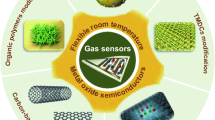Abstract
The influence of the modification of the surface of ZnO and SnO2 sensors with 5,10,15,20-tetraphenylporphyrin on the parameters of sensor response to high-volatility organic substances was analyzed. The organic substances used were ethanol, acetone, and benzene. The sensor response was characterized by specific sensitivity γ determined as the ratio between a change in the resistance of the sensitive sensor layer and the volume concentration of high-volatility organic compounds introduced into the system. The modification of the sensors with tetraphenylporphyrin caused changes in sensor response, including a change in the sign of the γ parameter, which was of importance for creating “electronic nose” sensor systems.
Similar content being viewed by others
References
I. Leray, M. C. Verniers, and C. Bied-Charreton, Sens. Actuators, B 54, 243 (1999).
D. P. Arnold, D. Manno, G. Micocci, et al., Thin Solid Films 329, 315 (1998).
A. Tepore, A. Serra, D. Manno, et al., Thin Solid Films 329, 341 (1998).
P. S. Barker, J. R. Chen, N. E. Agbor, et al., Sens. Actuators, B 18, 143 (1994).
Salleh M. M. Akrajas, and M. Yahaya, Sens. Actuators, B 105, 191 (2003).
M. Andersson, M. Holmberg, M. Lundstrom, et al., Sens. Actuators, B 89, 567 (2001).
R. Paolesse, C. Di Natale, A. Macagnano, et al., Sens. Actuators, B 53, 70 (1998).
S. I. Rembeza, Priroda (Moscow, Russ. Fed.), No. 2, 5 (2005).
I. A. Myasnikov, V. Ya. Sukharev, L. Yu. Kupriyanov, and S. A. Zav’yalov, Semiconductor Sensors in Physicochemical Investigations (Nauka, Moscow, 1991) [in Russian].
A. M. Gulyaev, O. B. Mukhina, I. B. Varlashev, et al., Sensor (ANO IRISEN), p. 10 (2001).
A. N. Frumkin, Zh. Fiz. Khim. 12, 337 (1938).
T. A. Ageeva, B. D. Berezin, M. B. Berezin, et al., in Advances in Porphyrin Chemistry (NII Khim., S.-Peterb. Gos. Univ., St. Petersburg, 1997), Vol. 1, p. 384 [in Russian].
A. B. Solov’eva, Doctoral Dissertation in Chemistry (Moscow, Inst. Chem. Phys., USSR Acad. Sci., 1989).
L. A. Shcherbachenko, V. A. Karnakov, and S. D. Marchuk, The Determination of Dipole Moments in Dilute Solutions (Debye’s Method): Methodological Recomendations (Irkutsk. Gos. Univ., Irkutsk, 2005) [in Russian].
A. B. Solov’eva, S. L. Kotova, P. S. Timashev, et al., Zh. Fiz. Khim. 77(1), 104 (2003) [Russ. J. Phys. Chem. 77 (1), 100 (2003)].
Author information
Authors and Affiliations
Corresponding author
Rights and permissions
About this article
Cite this article
Belkova, G.V., Zav’yalov, S.A., Sarach, O.B. et al. The character of the response of ZnO and SnO2 sensors modified with porphyrins to volatile organic compounds. Russ. J. Phys. Chem. 82, 2323–2328 (2008). https://doi.org/10.1134/S0036024408130281
Received:
Published:
Issue Date:
DOI: https://doi.org/10.1134/S0036024408130281




